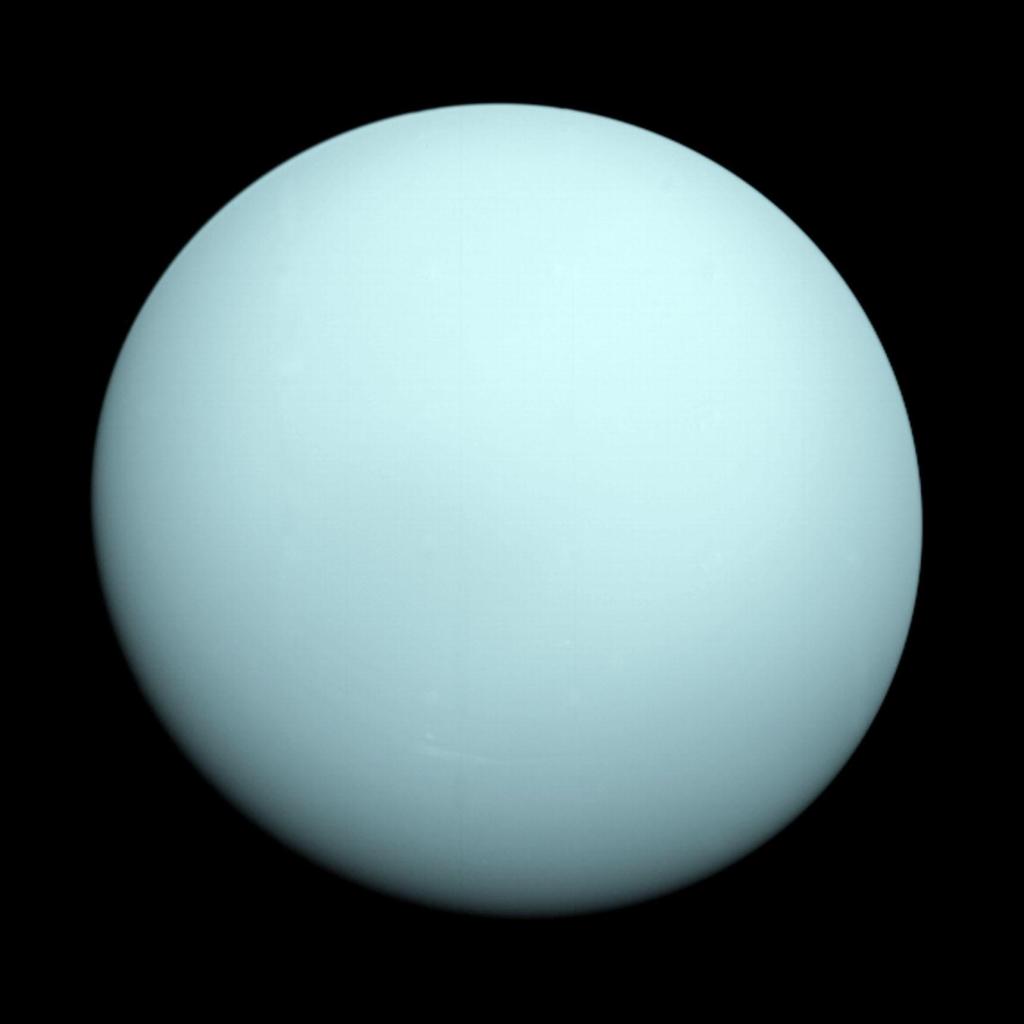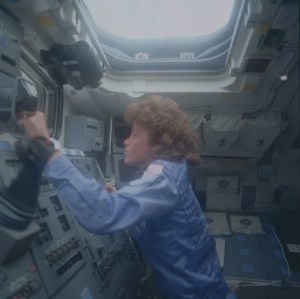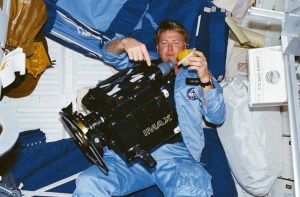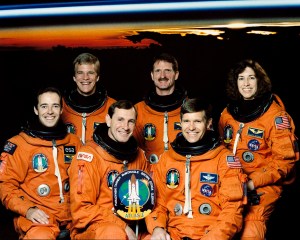One of the unique attributes of the Space Shuttle featured the ability to launch satellites into space and return them to Earth if needed. That capability passes its first test during the STS-51A mission in November 1984. Earlier in the year, the crew of STS-41B successfully deployed two communications satellites from Space Shuttle Challenger’s cargo bay – Westar 6 for Western Union and Palapa B2 for Indonesia. The Payload Assist Module (PAM) upper stages of both satellites malfunctioned, leaving them in non-useable 160-by-600-mile high orbits instead of the intended 22,300-mile high geostationary orbits required for their normal operations. While both satellites remained healthy, their own thrusters could not boost them to the proper orbits. So NASA devised a plan to have astronauts retrieve the satellites during Extravehicular Activities (EVAs) or spacewalks using the jetpack known as the Manned Maneuvering Unit (MMU), after which the shuttle’s Canadian-built Remote Manipulator System (RMS) or robot arm would grapple them and place them into the cargo bay for return to Earth. Astronauts had demonstrated the capability of the MMU during the STS-41C Solar Max satellite repair mission in April 1984 and NASA felt confident of its ability to capture and return Westar and Palapa.
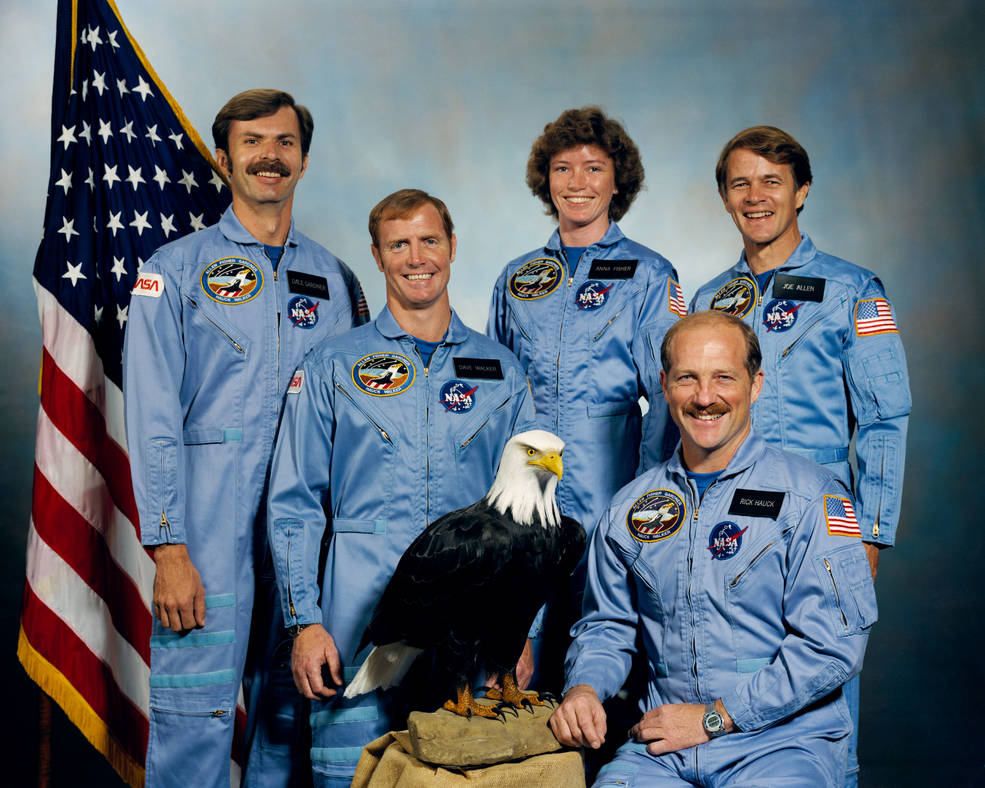
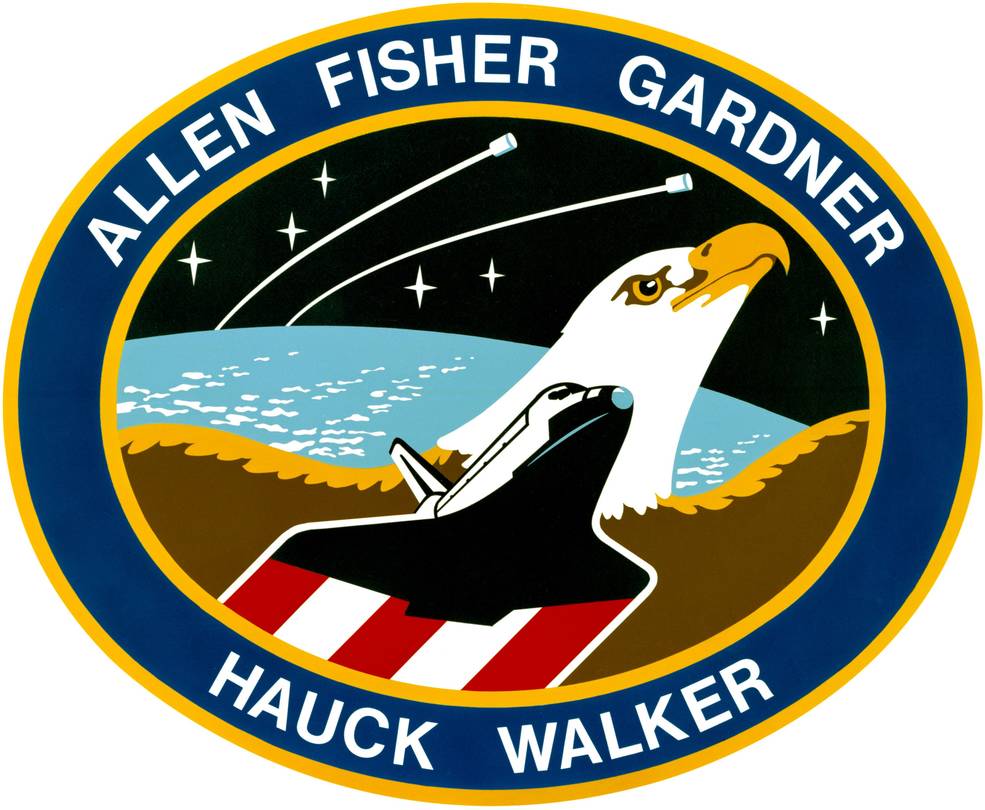
Left: STS-51A crew photo (left to right): Gardner, Walker, Fisher, Hauck, and Allen. Right: STS-51A crew patch.
The crew of STS-51A consisted of Commander Frederick H. “Rick” Hauck, Pilot David M. Walker, and Mission Specialists Joseph P. Allen, Anna L. Fisher, and Dale A. Gardner. Hauck, Allen, and Gardner were making their second trip into space while Walker and Fisher were the rookies on the flight. Fisher had the distinction of being the first mother in space. In addition to the return of Westar 6 and Palapa B2, the astronauts’ mission included deploying two communications satellites, Anik D2 for Telesat of Canada and Leasat 1 (also known as Syncom IV-1) for the US Navy.
In the weeks prior to STS-51A, ground controllers lowered the orbits of both satellites and reduced their spin rates from 50 to 1 rpm to enable capture by the shuttle astronauts. Engineers at NASA’s Johnson Space Center in Houston developed the Apogee Kick Motor Capture Device (ACD), otherwise known as the stinger due to its appearance, to allow one of the astronauts to capture the satellites while flying the MMU. Once relocated over the payload bay, a second astronaut would remove the omnidirectional antenna with pruning shears and install an Antenna Bridge Structure (ABS) with a grapple fixture over the satellite’s main antenna dish. The RMS would then grapple the satellite by this second fixture and lower into the specially-built cradle to secure it into the payload bay.
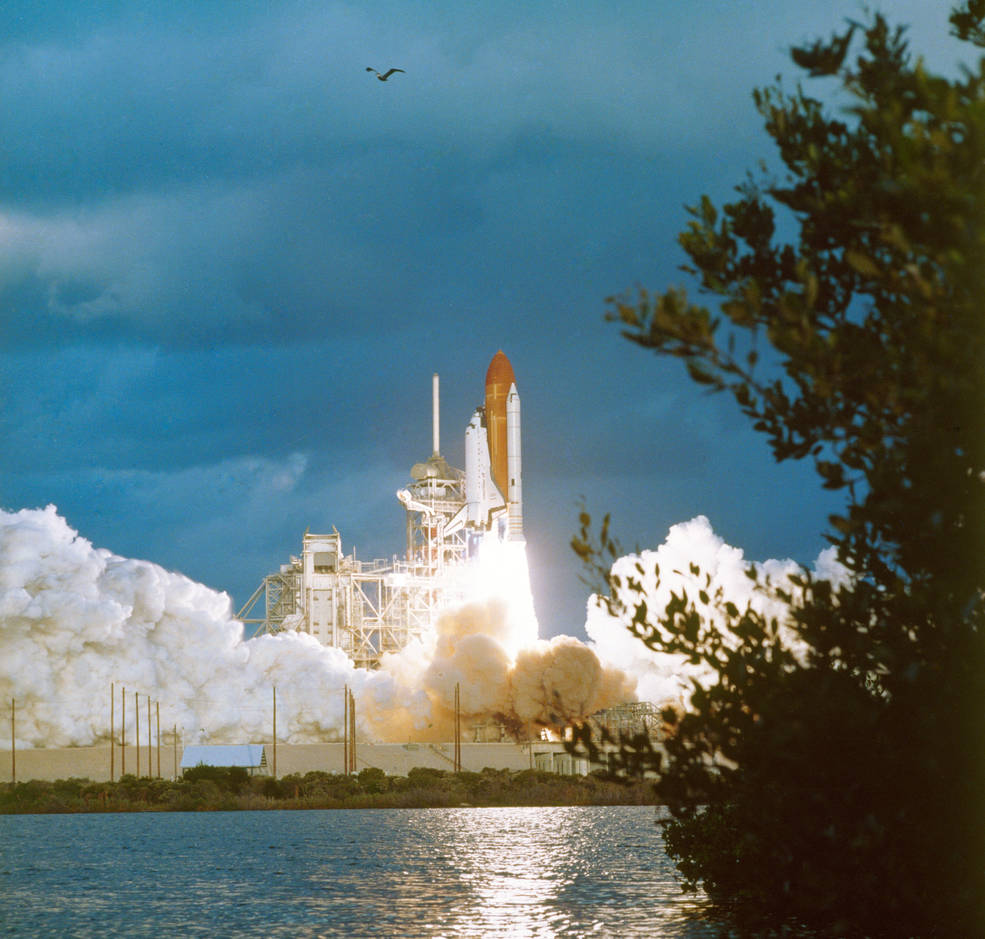
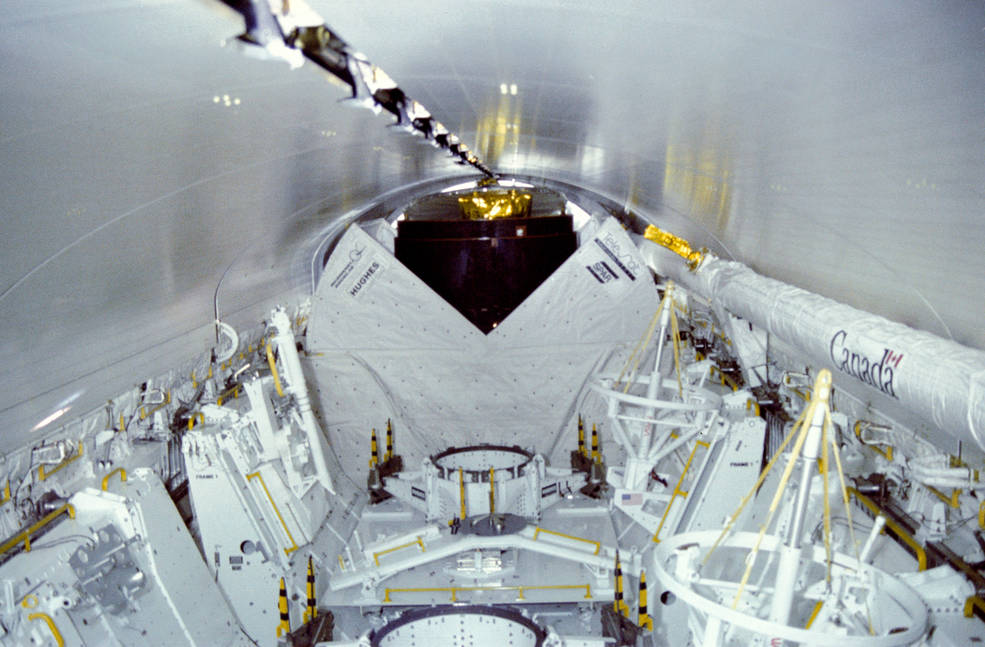
Left: Launch of Discovery on the STS-51A mission. Right: View inside Discovery’s payload bay shortly after orbital insertion – the top of Anik D2 is visible, with Leasat 1 hidden behind it.
Space Shuttle Discovery roared off Launch Pad 39A at Kennedy Space Center (KSC) on Nov. 8, 1984, marking its first return to space, to begin the STS-51A mission. The launch took place just 26 days after the landing of the previous mission, STS-41G, a then record-breaking turnaround time between shuttle flights. Eight and a half minutes after liftoff, Discovery and its five-member crew were in space and shortly thereafter settled into a 182-by-172-mile high initial orbit. As their first order of business, the crew checked out the RMS to ensure its functionality for the satellite captures later in the mission. They also performed the first rendezvous burn. The crew then settled down for its first night’s sleep in orbit.
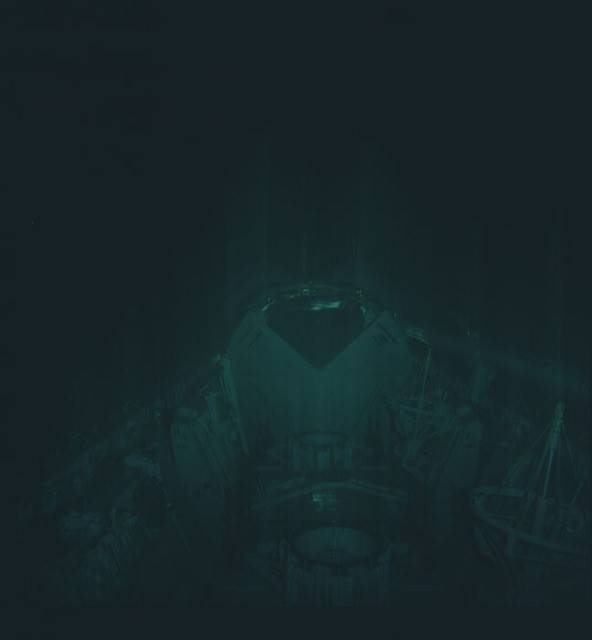
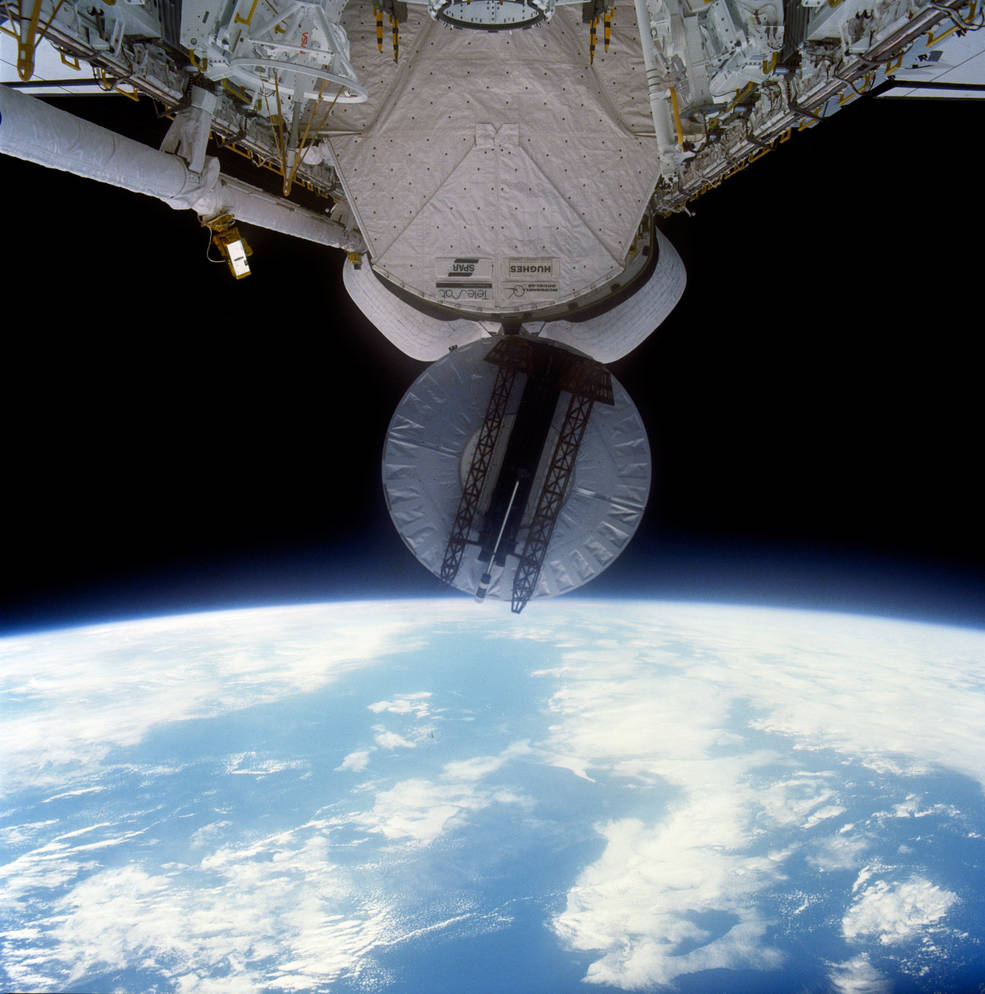
Left: Nighttime deploy of Anik D2 satellite. Right: Deploy of Leasat 1 satellite.
The primary activity of the second flight day involved the deployment via a spring ejection mechanism of the 2,727-pound Anik D2 satellite, which occurred on time and with no issues. As the first nighttime satellite deployment from the shuttle, photographs of the activity are somewhat less than clear. The crew also circularized the shuttle’s orbit at 186 miles. The next day, the astronauts deployed the 17,000-pound Leasat 1 using the same Frisbee style mechanism used to deploy the first Leasat during the STS-41D mission earlier in the year. With the satellite deployments complete, the crew began to focus on the rendezvous maneuvers to bring them close to the Palapa B2 satellite while Allen and Gardner verified the functionality of their spacesuits. On flight day 4, the astronauts reduced the pressure inside the Shuttle from 14.7 pounds per square inch (psi) to 10.2 psi in order to prevent the spacewalking astronauts from developing the bends inside the spacesuits that operated at 4.3 psi.
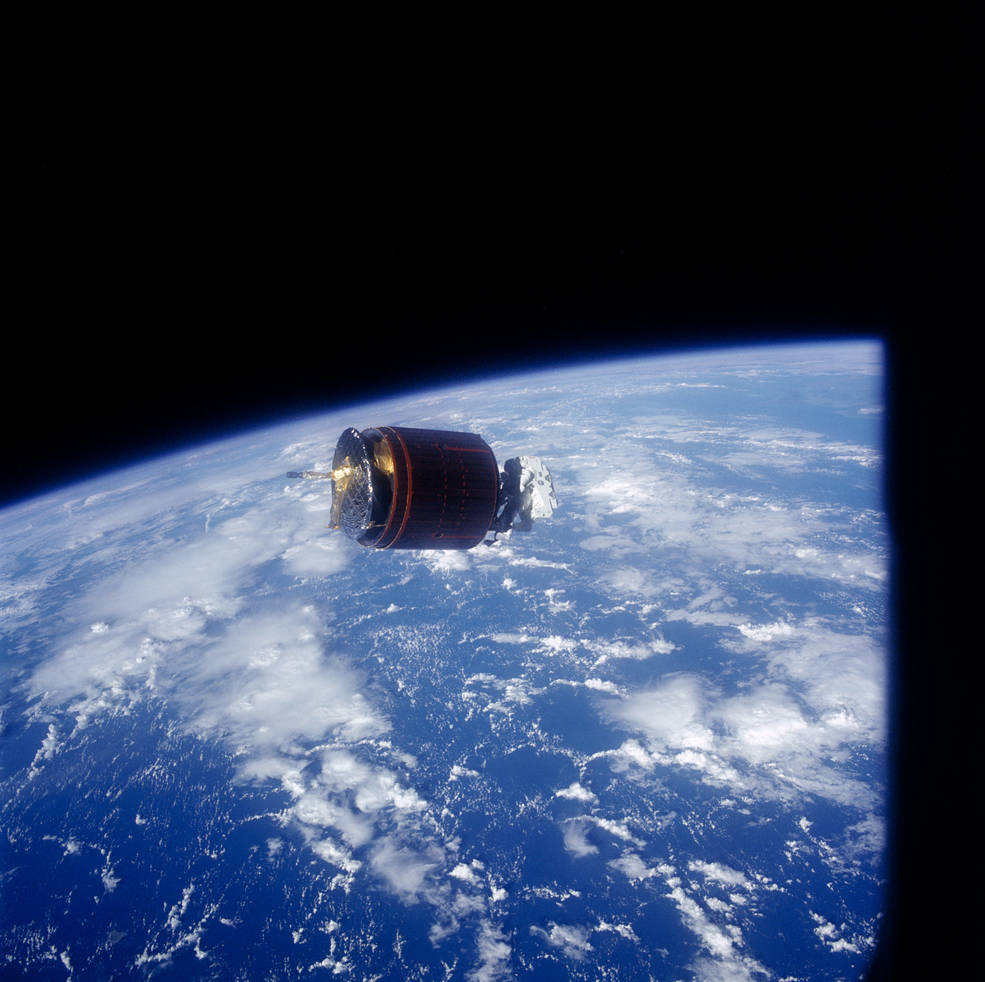
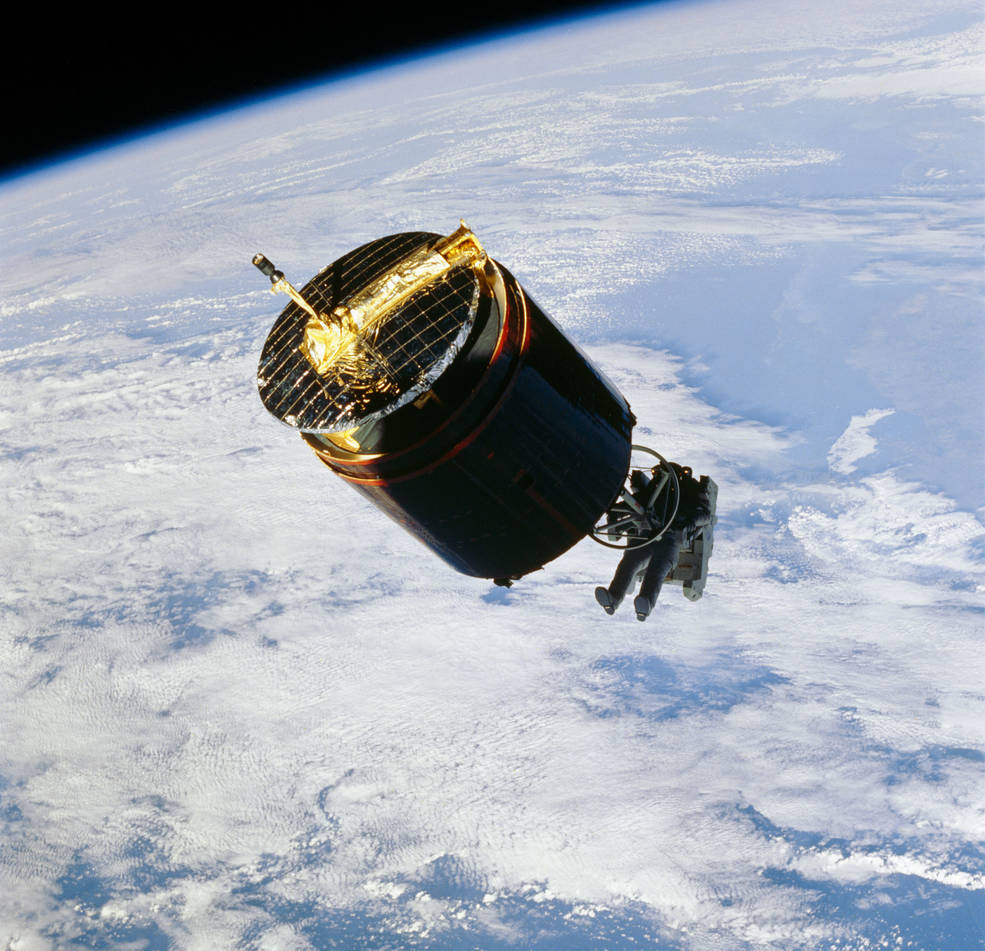
Left: During the first EVA, Allen captures the Palapa B2 satellite. Right: Gardner about to capture Westar 6 during the second EVA.
On the fifth mission day, after Hauck and Walker piloted Discovery to within 35 feet of Palapa, Allen and Gardner exited the airlock to begin the spacewalk portion of the satellite capture. Allen donned the MMU mounted on the side wall of the cargo bay, attached the stinger to its arms, and flew out to Palapa. Once there, he inserted the stinger into the satellite’s Apogee Kick Motor bell and using the MMU’s attitude control system stopped Palapa’s spin. Fisher then steered the RMS to capture a grapple fixture mounted on the stinger between Allen and the satellite. She then maneuvered the satellite over the payload bay where Gardner awaited to remove its omnidirectional antenna and install the bridge structure. However, Gardner was not able to attach the ABS to the satellite due to a clearance issue on the satellite that was unknown before flight. Using a backup plan, Allen undocked from the stinger, leaving it attached to the satellite as well as the RMS, and stowed the MMU in the payload bay. With Allen now holding the satellite by its antenna, Gardner attached an adaptor to the bottom end of the satellite to secure it in its cradle in the payload bay. This plan worked and Allen and Gardner completed the EVA in exactly six hours.
Between the two EVA days, the crew serviced the spacesuits, conducted routine maintenance on the shuttle, and prepared for the second rendezvous, this time to retrieve Westar. Allen and Gardner switched roles for the second EVA on flight day seven, with Gardner flying the MMU to capture Westar. The astronauts repeated the procedure from the first EVA, with the exception of not removing the omni antenna so they could use it as a handhold. With Westar secured in the payload bay, Gardner and Allen completed the second EVA in 5 hours and 42 minutes.
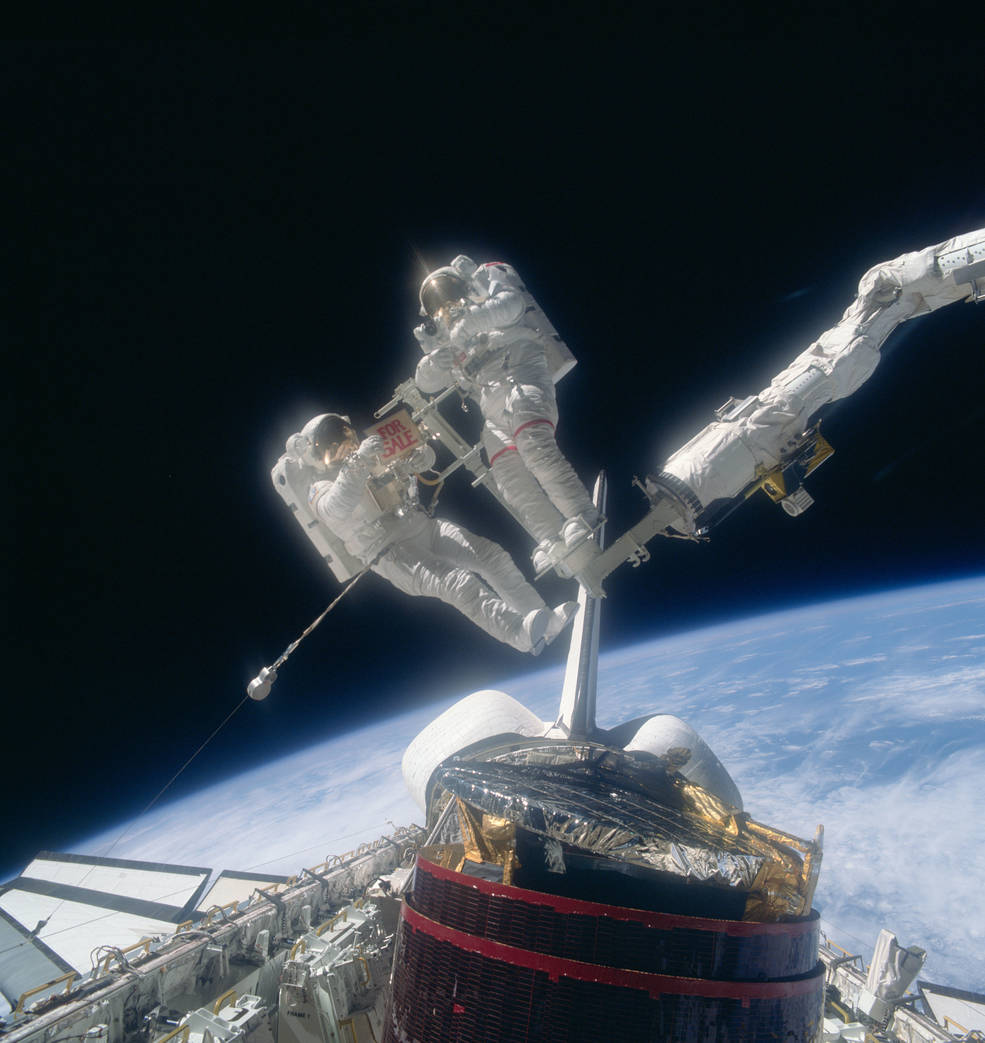
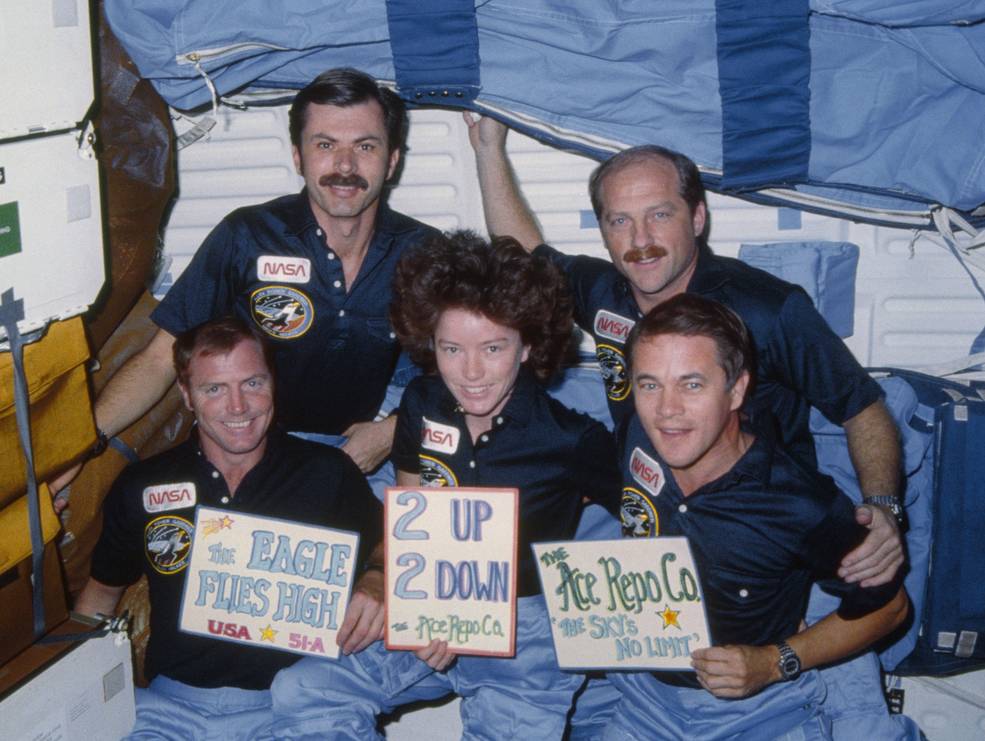
Left: Gardner (left) and Allen pose at the end of the RMS controlled by Fisher, holding a For Sale sign above the two retrieved satellites secured in Discovery’s payload bay. Right: Inflight photo of the STS-51A crew (front, left to right) Walker, Fisher, and Allen, (back, left to right) Gardner and Hauck, after the successful satellite retrievals.
During their final full day in space, Discovery’s crew repressurized the Shuttle to 14.7 psi and tidied the cabin in preparation for reentry. On Nov. 16, the astronauts closed the payload bay doors and fired the Orbital Maneuvering System engines to begin the descent back to Earth. Hauck guided Discovery to a smooth landing at KSC, completing a flight of 7 days, 23 hours, and 45 minutes. The crew had traveled nearly 3.3 million miles and completed 127 orbits around the Earth.
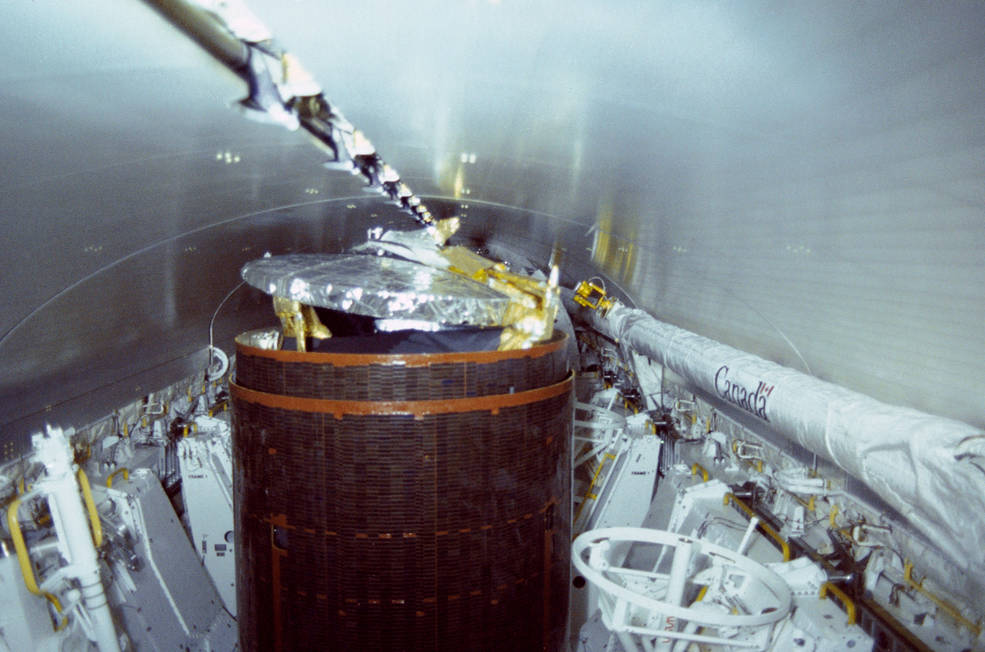
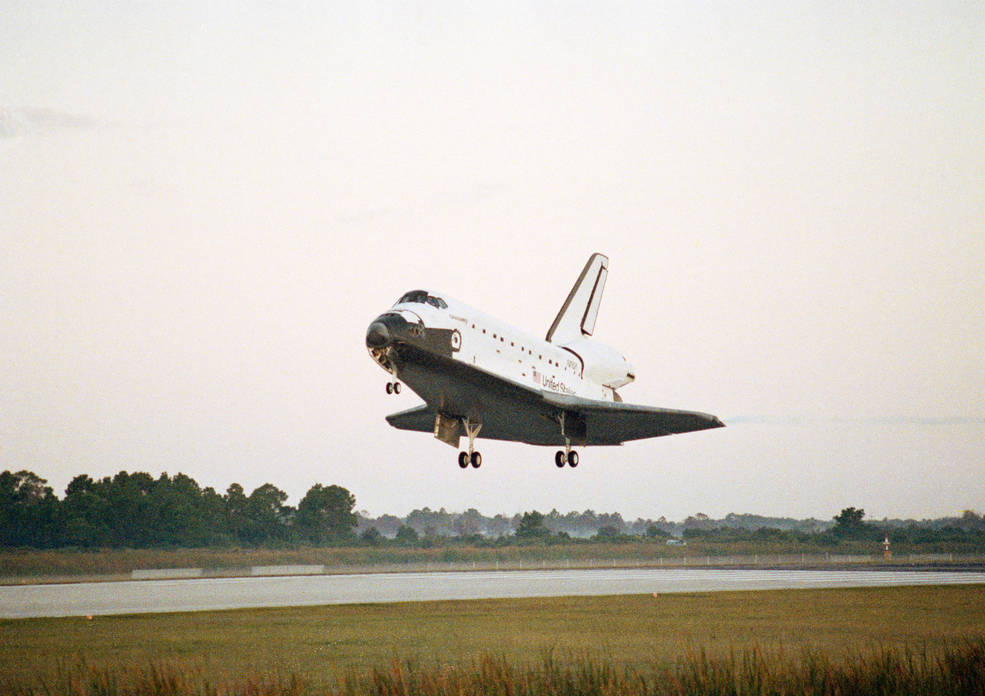
Left: View inside Discovery’s payload bay shortly before the deorbit burn, with Westar 6 in the foreground and Palapa B2 behind it – compare with image above taken shortly after launch.
Right: Discovery moments before touchdown at KSC.
Read recollections of the STS-51A mission by Hauck, Allen, and Fisher in their oral histories with the JSC History Office. Enjoy the crew’s narration of a video about the STS-51A mission.
As a postscript, STS-51A marked the last flight to use the MMUs, and the last untethered EVAs until 1994 when STS-64 astronauts tested the Simplified Aid for EVA Rescue (SAFER). All EVAs on the Space Shuttle and the International Space Station since then have used safety tethers, with the SAFER as a backup in case a crewmember disconnects from the vehicle. Hong Kong-based AsiaSat purchased the Westar 6 satellite, refurbished it, and relaunched it as AsiaSat 1 on April 7, 1990, on a Chinese CZ-3 rocket. Title to the Palapa B2 satellite returned to Indonesia after its relaunch as Palapa B2R on April 13, 1990, aboard a Delta rocket.


